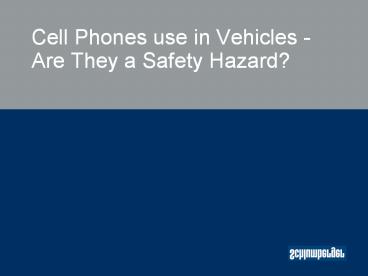Cell Phones use in Vehicles - Are They a Safety Hazard? - PowerPoint PPT Presentation
Title:
Cell Phones use in Vehicles - Are They a Safety Hazard?
Description:
Title: Cell Phone Safety On the Road Last modified by: Digital Business Client User Created Date: 3/7/2000 9:15:44 PM Document presentation format – PowerPoint PPT presentation
Number of Views:68
Avg rating:3.0/5.0
Title: Cell Phones use in Vehicles - Are They a Safety Hazard?
1
Cell Phones use in Vehicles - Are They a Safety
Hazard?
2
Do You Drink Alcohol and Drive ?
Do You talk on a Phone While Driving?
What's the Connection?
3
Both Activities Could Kill You
Or Kill Some Other Innocent Person
4
Countless Studies have been done in the past
decade and all have conclusively found that
talking on a cell phone while driving increases
the risk of an accident by as much as 4 times.
The increased risk is compared to driving while
impaired by alcohol.
5
Cell Phones
Car Phones
Mobile Phones
Bat Phones
Shoe Phones
No matter what you call it, the issues are the
same
There are times to have and need a phone and
times when not to use them
6
Positives of Cell Phones
Call for help with disabled vehicle
Call for help when lost
Call for help when stuck
7
Positives of Cell Phones
Call to 911 to report an accident
Call to report aggressive drivers
Call to police when in danger
Call if late for appointment
Call to report drunk drivers
8
Negatives of Cell Phones
In-car distraction
Increased response time
Increased cases of non-response
9
Hands Free Vs. Hand Held
- Believe it or not, It is not the dexterity
required to use a cell phone that causes the
increased risk of a crash, but the drivers
ability to allocate attention
10
Hands Free Vs. Hand Held
- Put another way,
- It is not whether you have both hands on the
wheel that matters, but rather whether you have
all of your mind on the task at hand, that being
Driving
11
Cell Phones Vs. Conversation with a Passenger
- A passenger can also see the high risk situations
developing and stop the conversation. - Conversations on cell phones tend to be more
intense than face to face. - While talking on the phone your mind tends to
wander to the setting at the other end of the
phone line.
12
Whats Coming in 2001
- More and more countries have already instituted
laws restricting the use of cell phones while
driving ( e.g. Brazil, Israel, Switzerland,
Malaysia, Singapore) - Lawyers are preying on accident victims and using
verifiable cell phone use to prove a condition of
negligence. - New higher tech phones are adding many more
features which will take the drivers mind even
further away from driving.
13
An Age Old Issue
- Age plays a major factor in the increased risk of
using cell phones while driving. - While on the phone, drivers over 50 years are 2-3
times more apt than younger drivers to not
respond in time, if they respond at all, to
dangerous situations.
14
The Survey Says
- 81 of drivers believe that it is dangerous to
use cell phones while driving. - 61 of them admitted that they still do it.
- 30 of them admitted to talking on the phone
frequently.
15
Conclusions from the Studies
- All forms of cell phone usage lead to significant
increases in non-response to highway situations
and increases in response times. - Complex intense conversations lead to the
greatest increase in risk - Business calls tend to be more intense than
social calls.
16
Conclusions from the Studies
- The distracting effect of cell phone usage among
drivers over age 50 is two to three times as
great as that of younger drivers - Prior experience with cell phones appears to bear
no relation to the distracting effect of cell
phone use.
17
Schlumberger Cell Phone Standard
- Schlumberger employees shall not initiate calls
while driving irrespective of the type of phone. - If a phone call is received while driving, the
employee shall identify the caller, and terminate
the call immediately. If a return call is
required the driver shall pull over at the first
available safe rest stop and then return the call.
18
Testimonial
- Last year a Schlumberger driver was traveling in
heavy traffic on a Louisiana highway when his
phone rang. He asked one of his 4 passengers to
answer it. Just seconds after the passenger
answered, the truck in front stopped sharply. The
SLB driver immediately noticed a vehicle
approaching from the rear at a high rate of
speed. The driver was able to brake suddenly and
swerve onto the shoulder just before the
following vehicle plowed into the back of the
slowing truck. The other vehicle and driver were
in bad shape after the collision. - If the SLB driver had taken the time to answer
his phone he probably would not have recognized
the sudden dangers and may have been seriously
rear-ended, potentially injuring all four
occupants
19
Look Closely. Can you spot the real dummy!
20
Questions
- Does your company have a cell phone policy?
- If not, who will write one?
- Independent of company policy what will you
choose to do in your personal life? - Will you honestly lead by example, not just with
your employees but more importantly with your
loved ones?

